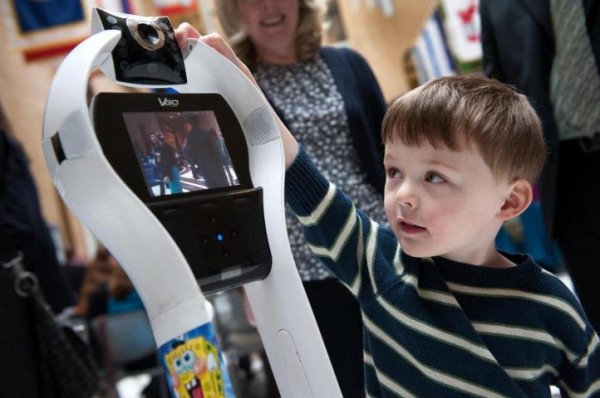The healthcare industry is experiencing revolutionary changes stemming from the rapidly shifting role of the patient within the continuum of care. This is resulting in high demand for easier access to healthcare professionals, access to online medical information, and alternatives to traditional care. There are few other places where this market shift has been more dramatic than in the area of telehealth technology. I thought I’d share three of my favorite implementations of telehealth as of late. The use of  these technologies (read: Robots!) is changing the way healthcare organizations deliver meaningful results to local and remote geographic locations.
these technologies (read: Robots!) is changing the way healthcare organizations deliver meaningful results to local and remote geographic locations.
Boston Children’s video monitoring robots
Boston Children’s has an impressive telehealth program that includes video-monitoring robots. These 4-foot-6, 17-pound, two wheel robots help with post-operative consultations. They act primarily as a means of videoconferencing, which gives the families of hospital patients a way to keep in touch with doctors and nurses in between post-surgical appointments. Equipped with cameras, audio gear and a video screen for a “face,” the robots are operated remotely by Children’s Hospital staff. In addition to facilitating communication, they can take video and close-up photos of surgical scars or other key areas of interest to help medical staff monitor recovery.
Providence Saint Joseph Sends Robots to Stroke Patients
Want more robots? You can find more robots via Providence Saint Joseph in Burbank. They will be using this telehealth technology to help stroke patients using a computer monitor to review initial tests, diagnose, and direct treatment. This robotic system includes indoor wayfinding technology that helps doctors direct the robots to patients within the unit. Why bring in the bots? Well, not all hospitals have interventional neurologists, and evidence shows that stroke patients have far better outcomes when they are treated as soon as possible by these neurologists. With technology, we can now make the very best specialists available to the world, or at least to the San Fernando Valley.
Children’s Hospital of Philadelphia’s REACH intervention
Don’t want robots? Well, you don’t need them to provide great care using telehealth technology. From a telehealth perspective, Children’s Hospital o Philadelphia offers home monitoring for infants using video and audio connection and clinical follow-ups through REACH intervention. REACH helps patients recognize early changes in health status before crisis. The REACH intervention uses daily online communication and a clinical information system that harnesses the power of speech technology to create a virtual home monitoring system using any telephone in combination in combination with video-conferencing and a web-based educational system. This model gives families the opportunity for visual and audio contact with sub-specialists, and provides a means of home-based clinical follow-up during the critical early weeks after surgery.
